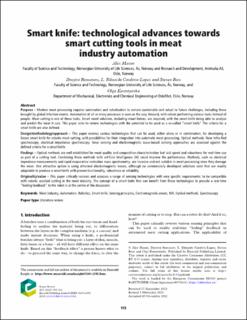| dc.contributor.author | Mason, Alex | |
| dc.contributor.author | Romanov, Dmytro | |
| dc.contributor.author | Cordova-Lopez, Luis Eduardo | |
| dc.contributor.author | Ross, Steven | |
| dc.contributor.author | Korostynska, Olga | |
| dc.date.accessioned | 2023-01-30T09:31:35Z | |
| dc.date.available | 2023-01-30T09:31:35Z | |
| dc.date.created | 2022-01-14T14:31:13Z | |
| dc.date.issued | 2022-01-05 | |
| dc.identifier.citation | Sensor Review. 2022, 42 (1), 155-163. | en_US |
| dc.identifier.issn | 0260-2288 | |
| dc.identifier.uri | https://hdl.handle.net/11250/3047012 | |
| dc.description.abstract | Purpose – Modern meat processing requires automation and robotisation to remain sustainable and adapt to future challenges, including those brought by global infection events. Automation of all or many processes is seen as the way forward, with robots performing various tasks instead of people. Meat cutting is one of these tasks. Smart novel solutions, including smart knives, are required, with the smart knife being able to analyse and predict the meat it cuts. This paper aims to review technologies with the potential to be used as a so-called “smart knife” The criteria for a smart knife are also defined.
Design/methodology/approach – This paper reviews various technologies that can be used, either alone or in combination, for developing a future smart knife for robotic meat cutting, with possibilities for their integration into automatic meat processing. Optical methods, Near Infra-Red spectroscopy, electrical impedance spectroscopy, force sensing and electromagnetic wave-based sensing approaches are assessed against the defined criteria for a smart knife.
Findings – Optical methods are well established for meat quality and composition characterisation but lack speed and robustness for real-time use as part of a cutting tool. Combining these methods with artificial intelligence (AI) could improve the performance. Methods, such as electrical impedance measurements and rapid evaporative ionisation mass spectrometry, are invasive and not suitable in meat processing since they damage the meat. One attractive option is using athermal electromagnetic waves, although no commercially developed solutions exist that are readily adaptable to produce a smart knife with proven functionality, robustness or reliability.
Originality/value – This paper critically reviews and assesses a range of sensing technologies with very specific requirements: to be compatible with robotic assisted cutting in the meat industry. The concept of a smart knife that can benefit from these technologies to provide a real-time “feeling feedback” to the robot is at the centre of the discussion. | en_US |
| dc.language.iso | eng | en_US |
| dc.publisher | Emerald | en_US |
| dc.relation.ispartofseries | Sensor Review;Volume 42, Issue 1 | |
| dc.relation.uri | https://www.emerald.com/insight/content/doi/10.1108/SR-09-2021-0315/full/html | |
| dc.rights | Navngivelse 4.0 Internasjonal | * |
| dc.rights.uri | http://creativecommons.org/licenses/by/4.0/deed.no | * |
| dc.subject | Meat industry | en_US |
| dc.subject | Automation | en_US |
| dc.subject | Robotics | en_US |
| dc.subject | Smart knives | en_US |
| dc.subject | Sensing principles | en_US |
| dc.subject | Electromagnetic waves | en_US |
| dc.subject | Spectroscopy | en_US |
| dc.title | Smart knife: technological advances towards smart cutting tools in meat industry automation | en_US |
| dc.type | Peer reviewed | en_US |
| dc.type | Journal article | en_US |
| dc.description.version | publishedVersion | en_US |
| dc.rights.holder | © Alex Mason, Dmytro Romanov, L. Eduardo Cordova-Lopez, Steven Ross and Olga Korostynska | en_US |
| cristin.ispublished | true | |
| cristin.fulltext | original | |
| cristin.qualitycode | 1 | |
| dc.identifier.doi | https://doi.org/10.1108/SR-09-2021-0315 | |
| dc.identifier.cristin | 1981317 | |
| dc.source.journal | Sensor Review | en_US |
| dc.source.volume | 42 | en_US |
| dc.source.issue | 1 | en_US |
| dc.source.pagenumber | 155-163 | en_US |
| dc.relation.project | EU/871631 | en_US |
| dc.relation.project | Norges forskningsråd: 281234 | en_US |

